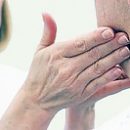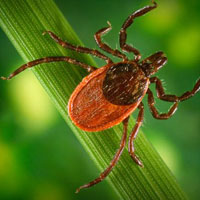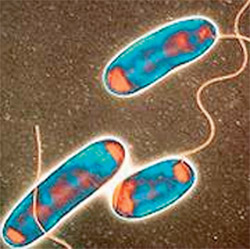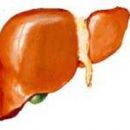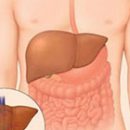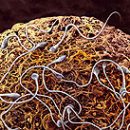What is a three-day fever, four-day? In our article, we deal with the main manifestations of the disease, as well as treatment of the disease.
Content
Malaria - also known as the names «swamp fever», «Intermittent fever», «Paroxysmal malaria», Acute infectious disease caused by several types of plasmodium simplicity (malaria plasmodium) and transmitted when bite of a mosquito genus ANOPHELES (Anofeles). For malaria, repeating attacks of strong chills, high temperature and abundant sweat are characterized. It is widespread in warm and wet regions with an average annual temperature 16° C and higher, also occurs in the zones of a more moderate climate and is completely absent in the indoor regions. The disease causes serious economic damage to countries with a tropical and subtropical climate, leading among all diseases as the main cause of disability and mortality of the population.
Three day malaria
 Benign three-day malaria is called P. Vivax (Plasmodium Vivax). After the bite, the first symptoms are developed by the first symptoms after 6-21 days: the strongest chill foreshadows the attack of high temperature, which lasts about 8 hours and ends with an abundant sweating. Such attacks are repeated every third day, but may be observed and more often, if in the period of infection, the contaminated mosquitoes were bused patient within a few days.
Benign three-day malaria is called P. Vivax (Plasmodium Vivax). After the bite, the first symptoms are developed by the first symptoms after 6-21 days: the strongest chill foreshadows the attack of high temperature, which lasts about 8 hours and ends with an abundant sweating. Such attacks are repeated every third day, but may be observed and more often, if in the period of infection, the contaminated mosquitoes were bused patient within a few days.
Fever attacks are accompanied by a rapid pulse and a decrease in blood pressure. At the height of the attack, symptoms of the lesion of the central nervous system appear: nausea, vomiting, delirium, sometimes develops a comatose state. Often anemia arises, due to the destruction of red blood cells by plasmodium budgeting. Typical symptoms also include loss of appetite, headache, painful sensations in the whole body (hands, legs, back). As a rule, after a few weeks, gradual recovery comes, but repeated attacks of the malarious fever can be observed within three or more.
Malignant three-day malaria
Lightning three-day malaria caused P. Falciparum and is the most severe form of malaria. Symptoms in this case are the same as with benign three-day malaria, but more pronounced and accompanied by more severe complications. For this form of malaria, the sticking of red blood cells is characterized and attaching them to the wall of small vessels (t.N. parasitic stakes), which leads to the blockage of capillaries. Functional disorders of the nervous system and gastrointestinal tract are often observed. Usually amazed liver and kidneys. The blockage of small brain vessels can lead to death. In case of recovery, the repetition of malaria seizures is rare.
Quartan
Creek fever. Otherwise, it is called hemoglobinurion fever - not frequent, but severe complication of malaria, usually malignant three-day malaria; It is found primarily in faces of the White race (especially those who took Kinein). For the draft fever, the rapid, massive destruction of red blood cells and the violation of the kidney function.
It develops after several attacks of malaria, manifesting a suddenly sharp rise of temperature, extreme weakness, or even sharp pressure reduction. A large amount of albumin - protein appears in the urine (it is not absent), as well as hemoglobin (complex protein - the carrier of oxygen and carbon dioxide, is located in the erythrocyte), which gives it a dark brown or dark red (where and the name of the syndrome). In the event of a complete impairment of the kidney function, death occurs. The mechanism for the development of the draft fever is not exactly established, but most often it is considered as an allergic reaction to malaria parasites.
Treatment includes absolute peace, blood transfusion, the use of antimalarial preparations. Hinin helps only in some cases, and sometimes has a negative effect.
Four-dimensional malaria is called P. malariae (malaria plasmodium); As a rule, it takes easier than other forms, but with it the likelihood of repeated fever attacks is highest. The incubation period is 1-6 weeks; Freedy develops at four-day intervals.
Treatment of malaria
For the laboratory determination of malaria, a drop of diluted blood is applied to the glass in the form of a thick smear, painted and examine under the microscope. If malaria plasmodia (the smallest parasites) are found, they are quite easy to calculate, knowing the number of individuals in the field of view and the multiplicity of blood sample breeding.
In a thin smear of blood painted according to the method of gymn, it is possible to identify the type of plasmodium, which caused the disease. With three-day malaria caused by P. Vivax, in blood preparations inside the erythrocytes, stems are visible (one of the forms of the plasma, larvae) in the form of a ring, as well as an amoeboid shape and gametocytes (subsequent forms of development of plasmodium from larvae to an adult individual). In addition, separate individuals are found plasma subjected to division, and sometimes destroyed red blood cells surrounded by measurement.
With four-day malaria in blood preparations, the same stages of development of plasmodium are observed, but individual individuals in P. Malariae larger than P. Vivax, and differ from the latter in the form and character of staining. When the malaria pathogen is P. Falciparum, in painted preparations, sides are present only in the form of a ring.
For the treatment of malaria, various drugs can prevent malaria attacks, quickly stop the symptoms of the starting attack or completely destroy the pathogen. Among them are the most famous for Chlorochin, Cinein, Meflohin, Primahin and Hinakrine Hydrochloride, also produced under the names of Atabrin and Akrichin. Persons planning a journey or long-term accommodation in endemic in malaria areas, it is recommended to regularly take antimalarial preparations, such as Chlorochin.
Immunity after malaria
In people who have suffered with malaria, the state of relative immunity (immunity) is developing, t.E. Re-infection with the same pathogen is accompanied by a more moderate fever with softer clinical manifestations, despite the same number of blood plasmodium. Over time, immunity is gradually weakening, and parasite remaining in the body can begin to multiply again and cause a new attack in a few months or even years.
Three main types of plasmodium causing malaria in humans exist in nature in the form of several strains (varieties). Each of the strains has only features inherent in it and is usually distributed only in certain areas. Thus, immunity manifests itself only to the strain that was the cause of primary infection.
People living in areas where malaria is common, tolerate this infection in early childhood. Recovered children become protected only to local strain. At the same time, they can remain asymptomatic carriers of malaria and promote its distribution among unprotected immunity persons, for example, who have not previously lived in this area.


